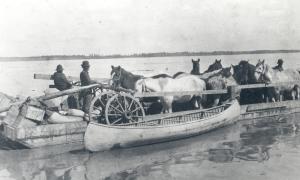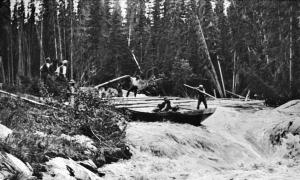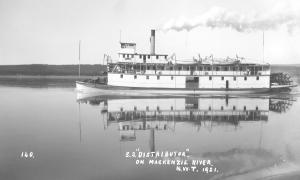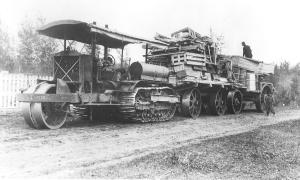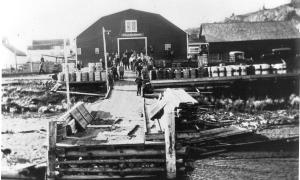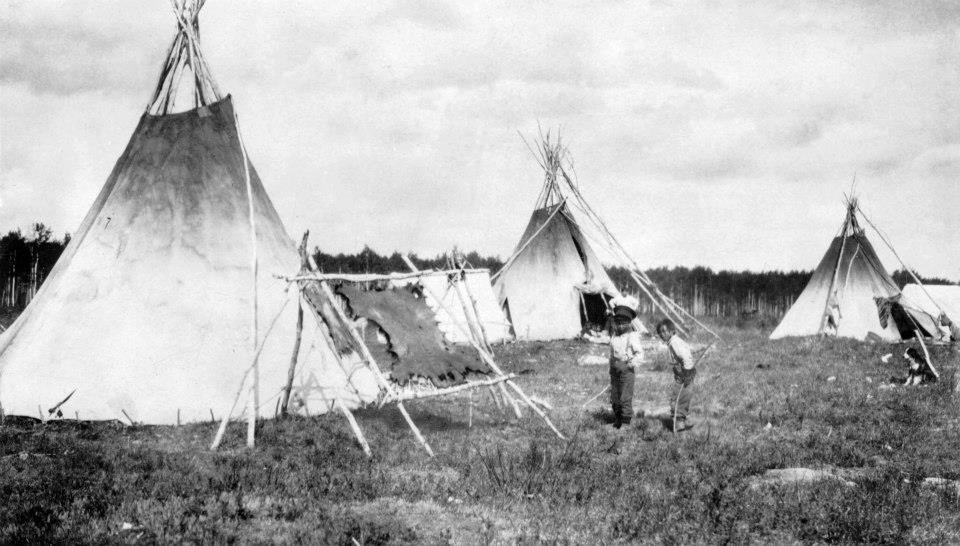
For centuries, the Dene and Metis hunted and fished the land and tributaries flowing into the Slave River. The waterway was key to their movements, following the ancient rhythms of animals and seasons. Explorers and fur traders later used the Slave as a gateway from the Prairies when travelling north from Lake Athabasca.
The Town of Fort Smith largely owes its existence to the four sets of formidable rapids on the Slave River. These rapids had to be portaged around by the fur traders who settled in the North. Portaging was originally done in three stages on the east bank of the river, but was eventually pared to a single 16-mile portage on the west bank.
In 1872, the Hudson's Bay Company built an outpost called Smith's Landing (Fort Fitzgerald) at “Cassette Rapids” the southern most set of the Slave River rapids. In 1874, the Hudson Bay Company established a second outpost at the “Rapids Of The Drowned” and named it Fort Smith after Donald Alexander Smith (later Lord Strathcona) the resident governor of the Hudson Bay Company and an original member of the North West Council. In between the outposts lie two more sets of rapids. Pelican Rapids and Mountain Rapids. For 200 years, all freight from the south travelled the Slave River on its way to the Arctic, until a highway to Hay River was built in 1949 and freight was transported to Great Slave Lake.
Within a few years, the Royal Canadian Mounted Police established its northern headquarters in Fort Smith. The Roman Catholic Church did the same for its Northern Diocese, building a mission in 1876 where the Oblate Brothers grew vegetables for missions along the Mackenzie River. In 1920 a federal government administration building was constructed to house the new Northwest Territories branch and the first court of justice in the Mackenzie District. The Union Bank of Canada opened the first bank in the Northwest Territories in Fort Smith in June 1921. One year later in 1922 Wood Buffalo National Park was established with its operations and administration headquarters in Fort Smith.
Fort Smith was supposed to become the capital of the Northwest Territories, headquarters for the Territorial Government, RCMP & The Catholic Church were right here, but the title was given to Yellowknife in 1967 due to its central location. Since Fort Smith really wanted to become the capital of something, it was decided that it would be the garden capital of the north. This is why you will see a lot of hanging baskets all over town and many planters with beautiful flowers.
In 1970, the Adult Vocational Training Center was opened. Its operations were later expanded and in 1981 it became Thebacha Campus. A few years later, Arctic College was created by the government of the Northwest Territories and merged with the Thebacha Campus to become the new headquarters. In 1995, the college changed its name to Aurora College to allow Nunavut the use of the Arctic College name.
Today, many federal and territorial government offices, including the headquarters of Aurora College & Wood Buffalo remain in Fort Smith. To hear more about the rich history and culture of Fort Smith, visit the Northern Life Museum & Cultural Centre.

